Ijraset Journal For Research in Applied Science and Engineering Technology
- Home / Ijraset
- On This Page
- Abstract
- Introduction
- Conclusion
- References
- Copyright
An IOT Based System for Early Identification & Monitoring of Covid-19
Authors: Dr. J. Seetaram, Sadaf , K. Manideep, Mohammed Tanveer
DOI Link: https://doi.org/10.22214/ijraset.2024.63180
Certificate: View Certificate
Abstract
This paper aims to introduce the design of an \"IoT-Based System for Early Identification and Monitoring of COVID-19,\" with a specific focus on the systematic monitoring of heart rate and SpO2 (oxygencarrying hemoglobin in blood) through Wireless Health Monitoring. In the context of our rapidly advancing world, where health holds increasing significance, continuous monitoring emerges as a crucial aspect. While health professionals traditionally play a vital role in individual health monitoring, the rising population poses challenges to their capacity. Particularly in the current pandemic scenario, global attention to health has become paramount. Despite the existence of numerous health monitoring devices, our proposed system distinguishes itself through its convenience and efficiency.
Introduction
I. INTRODUCTION
In the contemporary landscape of advancing technology and burgeoning global health concerns, the need for innovative, accessible, and efficient healthcare solutions has become increasingly imperative. The unprecedented challenges posed by the COVID-19 pandemic have underscored the criticality of early detection and continuous monitoring of vital health parameters such as heart rate and oxygen saturation (SpO2). This paper presents an IoT-based system tailored specifically for the early identification and ongoing monitoring of COVID-19 symptoms through wireless health monitoring. In response to these challenges, this research introduces a groundbreaking solution—IOT- based monitoring and controlsystem using ESP 32.
This innovative approach not only prioritizes real- time monitoring capabilities but also seamlessly integrates automation into the control processes. At the core of this system is the versatile ESP32 microcontroller, chosen for its robust Wi-fi capabilities. This paper delineates the design, development, and deployment of the IoT-based health monitoring system, focusing on its capability to monitor heart rate and SpO2 wirelessly. The primary objectives include elucidating the system architecture, detailing the integration of key components, validating the system's efficacy through experimental analysis, and highlighting its potential implications in the healthcare domain. The scope encompasses both the technical intricacies of the system's implementation and the broader impact of its utilization in mitigating healthcare challenges posed by the COVID-19 pandemic and beyond A defining feature of our system is its seamless connectivity, enabled by the ESP32's Wi-Fi capabilities. This facilitates remote monitoring from any location with internet access, effectively overcoming a significant limitation in many existing systems. Notably, while remote monitoring is enabled, the control processes are designed to function autonomously, minimizing the need for external interference.
Given the increasing importance of health in our advancing world, continuous monitoring becomes imperative. The proposed device distinguishes itself for its convenience and efficiency, offering a wireless solution for health monitoring. In the current pandemic scenario, global attention to health underscores the significance of innovations that facilitate remote monitoring acute respiratory syndrome coronavirus has affected millions of individuals globally, leading to a staggering death toll surpassing three million. The impact ofthis virus extends beyond physical health, as it has the potential to induce multiple organ damage, particularly affecting the cardiovascular and respiratory systems. Moreover, the measures implemented to curb the pandemic, including self- isolation, travel restrictions, and social distancing, can have adverse effects on mental health.
The World Health Organization (WHO) has recommended various measures and policies to control the global spread of the virus, and these have been implemented to varying degrees at the local level. Different countries find themselves in distinct phases of the outbreak, resulting in diverse policies and measures over time. However, despite variations, there are commonalities in the strategies employed across nations. Strict enforcement of national policies and guidelines for individuals in some countries has played a significant role in reducing the transmission of SARSCoV-2. Despite concerted efforts, the pandemic continues to wreak havoc worldwide, leading to a persistent rise in the number of infected patients.
The challenges posed by COVID- 19 underscore the importance of global cooperation and the need for ongoing research and implementation of effective public health measures to address both the immediate and long-term impacts of the pandemic.
II. RELATED WORKS
The paper An IoT based framework for early identification & monitoring of Covid-19 has proposed an IoT-based structure to lessen the effect of transmittable infections. The proposed structure was utilized to utilize potential Coronavirus case data and wellbeing records of affirmed COVID-19 cases to foster an AI based prescient model for sickness, as well concerning investigating the therapy reaction. The system additionally imparts these outcomes to medical services doctors, who can then answer quickly to thought cases recognized by the prescient model by circling back to any further clinical examination expected to affirm the case. This permits the affirmed cases to be secluded and given suitable medical care. A trial was directed to test eight AI calculations on a genuine Coronavirus dataset. They are: (1) Support Vector Machine, (2) Neural Network, (3) Naïve Bayes, (4) K-Nearest Neighbor (K-NN), (5) Decision Table, (6) Decision Stump, (7) OneR, and (8) ZeroR. The outcomes showed that this multitude of calculations, with the exception of the Choice Stump, OneR, and ZeroR accomplished correctnesses of more than 90 %. Utilizing the five best calculations would give viable and precise ID of likely instances of Coronavirus. Utilizing the proposed ongoing structure might actually decrease the effect of transmittable infections, as well as death rates through early recognition of cases. This system proposed by [1] Mwaffaq Otoom would likewise give the capacity to circle back to recuperated cases, and a superior figuring out the infection.
The proposed IoT smart health checking framework by
- Mohammad Monirujjaman khan, Keerthana. D. Naresh Babu, Nivethitha, Gayatri, Leando gives straightforwardness to the specialists to distinguish the patients' data exclusively just on the presentation screen at their place. Specialists can recognize the information of the specific patient in regards to past qualities with the current one. Alongside information signing on the cloud, the Web of things gives chances to add further developed highlights or advantages and more biomedical sensors to this framework. Hence, the innovation of IoT makes this checking framework more adaptable and more updatable in future. In this proposed work, we enjoy taken benefit of innovation to make patients lives simpler for determination and treatment by observing an individual's pulse, oxygen level, and temperature.
- Nunung Nurul Qomariyah, Maria Seraphina work of IoT-based COVID-19 Patient Vital Sign Monitoring proposed a framework plan of IoT-based Early Admonition Framework in an electronic stage. It additionally showed general utilization of the framework, which can help the two patients at home and in the clinic. This proposed arrangement intends to take care of the issue of the lack of medical services laborers who are expected to deal with the Coronavirus cases.
Expanding upon this establishment, another review [4] Muhammad Irsyad Abdullah; Lilysuriazna Raya: A health check system for covid-19 patients using IoT proposes utilizing IoT that empowers clinical staff to remotely screen their patient. This will help bringing down the gamble of contamination among medical care staff and ease the rising interest for PPE (individual defensive hardware) packs and different necessities.
3. Mohammad Akuzubaidi, Zaid Albataineh presents a precise method for Coronavirus distinguishing proof, lung and sore division, and patient seriousness rating utilizing CT filters in this proposition. They introduced and dissected various state of the art division networks to find the top performing AI calculations.
4. Junaid Rasheed, Fouzia Jabeen introduced an extensive variety of IoTs advances which can be utilized in diagnosing and observing the tainted people and area of interest regions. Besides, it distinguish the difficulties and furthermore give our vision about the future exploration on COVID-19.
A few examinations of [7] Wei Jiang; Sumit Majumder include a wearable health system for examining covid-19 and other chronic diseases, which incorporates the equipment and a cell phone application, showed promising outcomes with execution tantamount to or better than comparative business gadgets, subsequently possibly making the proposed framework an optimal wearable answer for long haul checking of Coronavirus patients and other constant infections.
One more methodology is investigated in research by
[8] Axel Heinrich and Tims, The TELECOVID study is intended to screen the physiological wellbeing status of Coronavirus positive-risk patients in home separation from a distance. Key essential boundaries are estimated constantly utilizing an in-ear biosensor innovation. This information is gushed to the facility progressively to empower ideal collaboration in the event of crumbling.
The last concentrate by [9] Michael Dommasch, Alexander muller persuaded that they have made a significant stage towards future clinical consideration choices with our Tele Covid study.
They had the option to show that it is feasible to get all clinically fundamental data by means of a remote observing framework and to get satisfactory measures from it immediately. The information move innovation required is accessible basically all over; the framework is in this way reasonable for being increased expeditiously whenever required.
Another review by [10] Ricardo, Edger. R, Alba M planned to foster a wearable gadget equipped for distinguishing early indications of Coronavirus by estimating human biometric signs of temperature, pulse and SpO2. As per the acquired outcomes the proposed framework was effectively carried out and approved. Their review exhibited a possible answer for securing biomedical signs in the ears, albeit great sign procurement can challenge.
[11] Dhruv R Seshadri original copy portrays clinically significant physiological measurements which can be estimated from business gadgets today and features their part in following the wellbeing, solidness, and recuperation of Coronavirus 19+ people and bleeding edge laborers. The objective scattering from this paper is to start a source of inspiration among bleeding edge laborers and designers toward creating computerized wellbeing stages for checking and dealing with this pandemic.
Another study [12] Rinto Priambodo, this study it tends to be inferred that an IoT-based patient observing framework can be created to screen Coronavirus patients who are doing self-confinement at home. The created framework is intended to screen patient's physiological boundaries, for example, pulse and blood oxygen immersion level. The framework is competent to gain information from a home heartbeat oximeter and send the information along with area data to a server to be checked by clinical staffs.
5. Krishnan DS, Gupta SC, Choudhury T. introduced a model which is for uniquely checking the advanced age patients and illuminating specialists and friends and family. So, we are proposing an imaginative venture to evade such unexpected passing rates by utilizing Patient Wellbeing Checking that utilizes sensor innovation and utilizations web to convey to the friends and family in the event of issues. This framework involves Temperature and heartbeat sensor for following patients wellbeing. Both the sensors are associated with the Arduino-uno. To follow the patient wellbeing miniature regulator is thus interacted to an LCD show and wi-fi association with send the information to the web-server (wireless detecting hub). In the event of any sudden changes in tolerant pulse or internal heat level alarm is sent about the patient utilizing IoT. This framework likewise shows patients temperature and heartbeat followed live information with timestamps over the Internetwork. In this way Persistent wellbeing observing framework in light of IoT utilizes web to actually screen patient wellbeing and helps the client checking their friends and family dorm work and saves lives.
6. Dandi Yang fundamental objective was to explore and examine different Profound learning procedures applied to clinical pictures for the analysis of Coronavirus. They have made a few datasets, from public stores, including X-Ray and CT-Scan pictures for multi-class and twofold class grouping errands. They have additionally approved VGG16 and ResNet profound learning structure models, for the characterization of Coronavirus chest X-Ray and CT- filter pictures. Preparing stage permitted us to change the models to lay out a more significant level of precision when contrasted with past works, as the exactness of the improved CNN models is consistently above 98% and the disarray lattices show not many misleading cases for parallel grouping of X-beam pictures. The outcomes show that the highlights got from the improved profound learning models could be coordinated into our work to assemble a powerful model. One of the huge discoveries in this paper is that with additional public data sets, information combination models can additionally increment demonstrative and prescient execution. The other is that our models could successfully help the virologists to analyze Coronavirus and help the radiologists in the battle against the flare-up of Coronavirus, showing up in the determination of basic patients in couple of moments, which could be vital in their treatment. As future exploration lines, we are now chipping away at multi-standards characterization to recognize pictures from datasets blending patients in with lung issues because of a few potential sicknesses, like tuberculosis, Helps, Coronavirus, and so forth. In addition, have not found datasets with metadata including phases of the illness to demonstrative the seriousness of the side effects.
III. EXISTING METHODOLOGY
Monitoring patients' health has become increasingly challenging for healthcare professionals, exacerbated by population growth. Both the elderly and the young face difficulties in traveling for health check-ups. The current pandemic further heightens the risks associated with leaving one's home. In the existing setup, the heart rate is measured using a Heartbeat Sensor. However, in the proposed system, the heartbeat sensor is utilized for ongoing heart rate monitoring. Unlike the current approach, which employs sensor fusion algorithms to detect body temperature and water levels, the proposed system triggers the activation of analert system and LCD display based on heart rate, body temperature, and pressure. This system is characterized by its precision, adaptability, portability, and efficiency.
IV. PROPOSED SYSTEM
The outline of the proposed system entails the integration ofsensors affixed to the patient's body for monitoring temperature and heartbeat. Additionally, two supplementary sensors are positioned within the patient's residence to monitor humidity and room temperature. These sensors are linked to a central control unit tasked with computing the data from all four sensors. Subsequently, these computed data sets are transmitted via an IoT cloud to a designated base station. From there, medical professionals can access the data remotely, enabling them to assess the patient's condition based on temperature, heart rate, and environmental factors. This facilitates informed decision- making and allows for timely interventions as necessary.
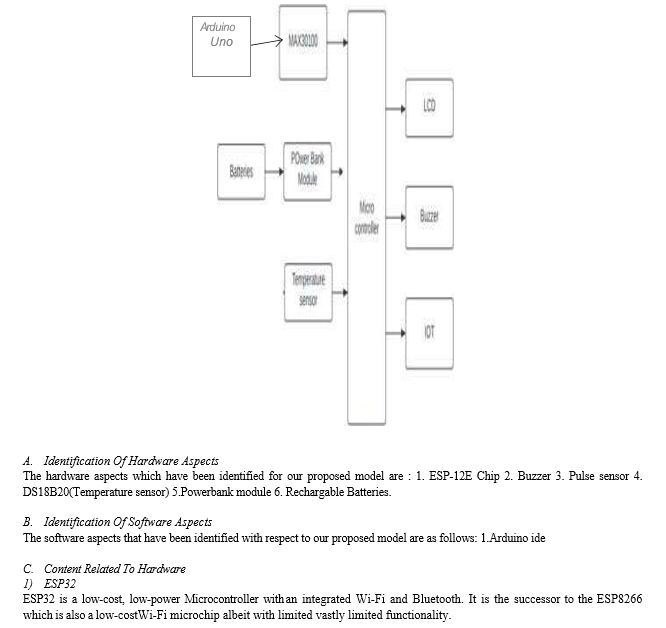
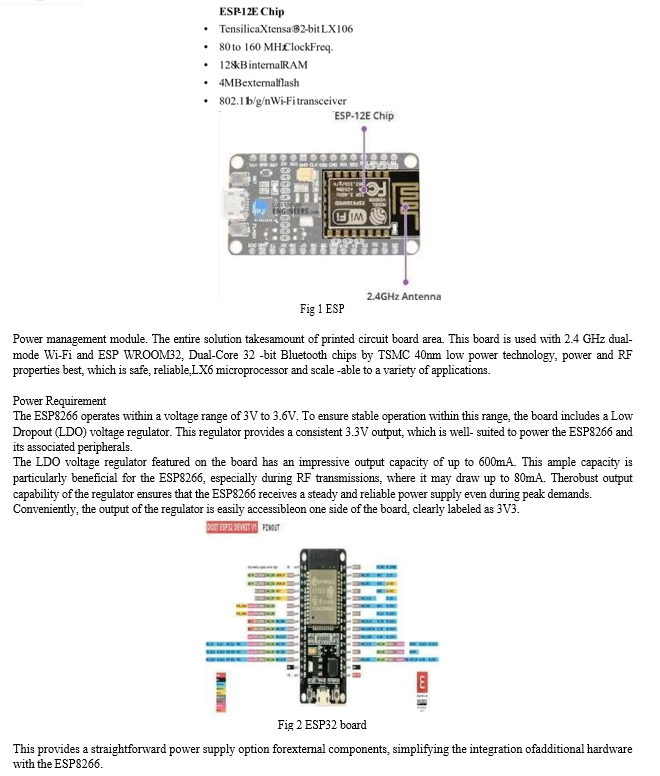
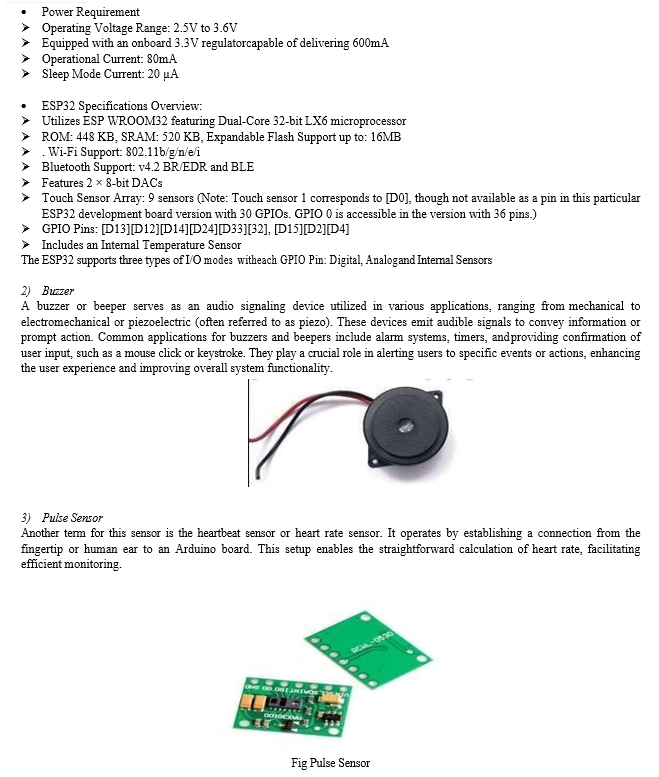
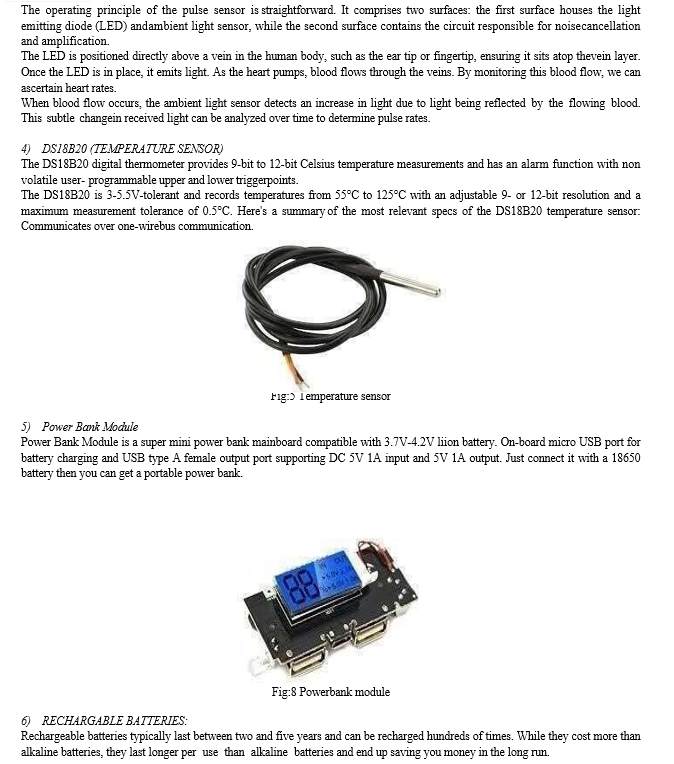
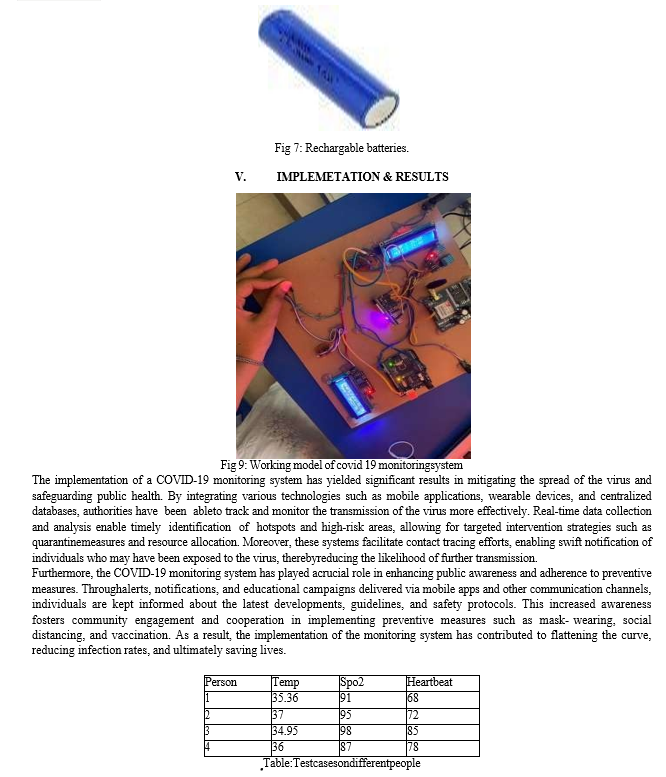
Conclusion
In conclusion, the implementation of a COVID-19 monitoring system represents a critical step towards mitigating the spread of the virus and safeguarding public health. By leveraging advanced technologies such as data analytics, machine learning, and real-time monitoring, such systems enable early detection of outbreaks, efficient contact tracing, and informed decision-making by health authorities. Through continuous surveillance of key indicators such as infection rates, testing data, and hospital admissions, these systems empower healthcare professionals to proactively respond to emerging trends and allocate resources effectively. Moreover, the integration of remote monitoring capabilities and wearable devices offers the potential for personalized health monitoring and early symptom detection among individuals at risk of COVID-19 exposure. By providing individuals with the tools to monitor their health status from the comfort of their homes, these systems not only reduce the burden on healthcare facilities but also empower individuals to take proactive measures to protect themselves and their communities. As the fight against COVID-19 continues, the development and deployment of robust monitoring systems remain essential tools in the global effort to combat the pandemic and ensure the health and well-being of populations worldwide.
References
[1] Mwaffaq Otoom “An IoT based framework for early identification & monitoring of Covid-19” [2] Elsevie,2020. [2].Mohammad Monirujjaman khan,Keerthana. D, Naresh Babu, Nivethitha, Gayatri, Leando, “,Iot based Smart Health Monitoring System for Covid-19 patients” Hindwai,2021. [3] Nunung Nurul Qomariyah; Maria Seraphina “IoT- based COVID-19 Patient Vital Sign Monitoring “, IEEE TRANSACTIONS ON BIOMEDICAL CIRCUITS AND SYSTEM ,2021. [4] Muhammad Irsyad Abdullah; Lilysuriazna Raya “Covid- 19 Patient Health Monitoring System Using IoT,CONTROL& SYSTEM GRADUATE RESEARCH COLLOQUIUM”,2022. [5] [Mohammad Akuzubaidi,Zaid Albataineh,”Covid- 19 Imamges diagnosis machine learning algorithm”,IEEE REVIEWS IN BIOMEDICAL ENGINEERING,2023 [6] Junaid Rasheed;Fouzia Jabeen,”IoT based engineering technologies for monitoring and diagnosing the Civid- 19”,IEEE IoT journal. [7] Wei Jiang; Sumit Majumder “A wearable tele health system towards monitoring Covid-19and chronic diseases”, IEEE PERVASIVE COMPUTING DIGITAL OBJECT IDENTIFIER ,2022 . [8] Axel Heinrich and Tims “Remote vital signs monitoring of Covid- 19 risk patients in home isolation with an In-Ear wearable”,IEEE REVIEWS IN BIOMEDICALS,2022 [9] Michael Dommasch, Alexander muller,\"Remote vital signs monitoring of COVID19 risk patients\",IEEE REVIEWS ON COVID MONITORING SYSTEM,2023 [10] Ricardo,Edger R. , Alba M “Remote vital signs monitoring of COVID19 risk patients”,IEEE EMBEDDED SYSTEMS VOL15,2023
Copyright
Copyright © 2024 Dr. J. Seetaram, Sadaf , K. Manideep, Mohammed Tanveer. This is an open access article distributed under the Creative Commons Attribution License, which permits unrestricted use, distribution, and reproduction in any medium, provided the original work is properly cited.

Download Paper
Paper Id : IJRASET63180
Publish Date : 2024-06-07
ISSN : 2321-9653
Publisher Name : IJRASET
DOI Link : Click Here
 Submit Paper Online
Submit Paper Online

